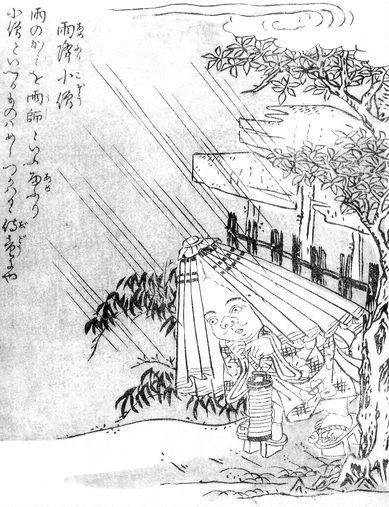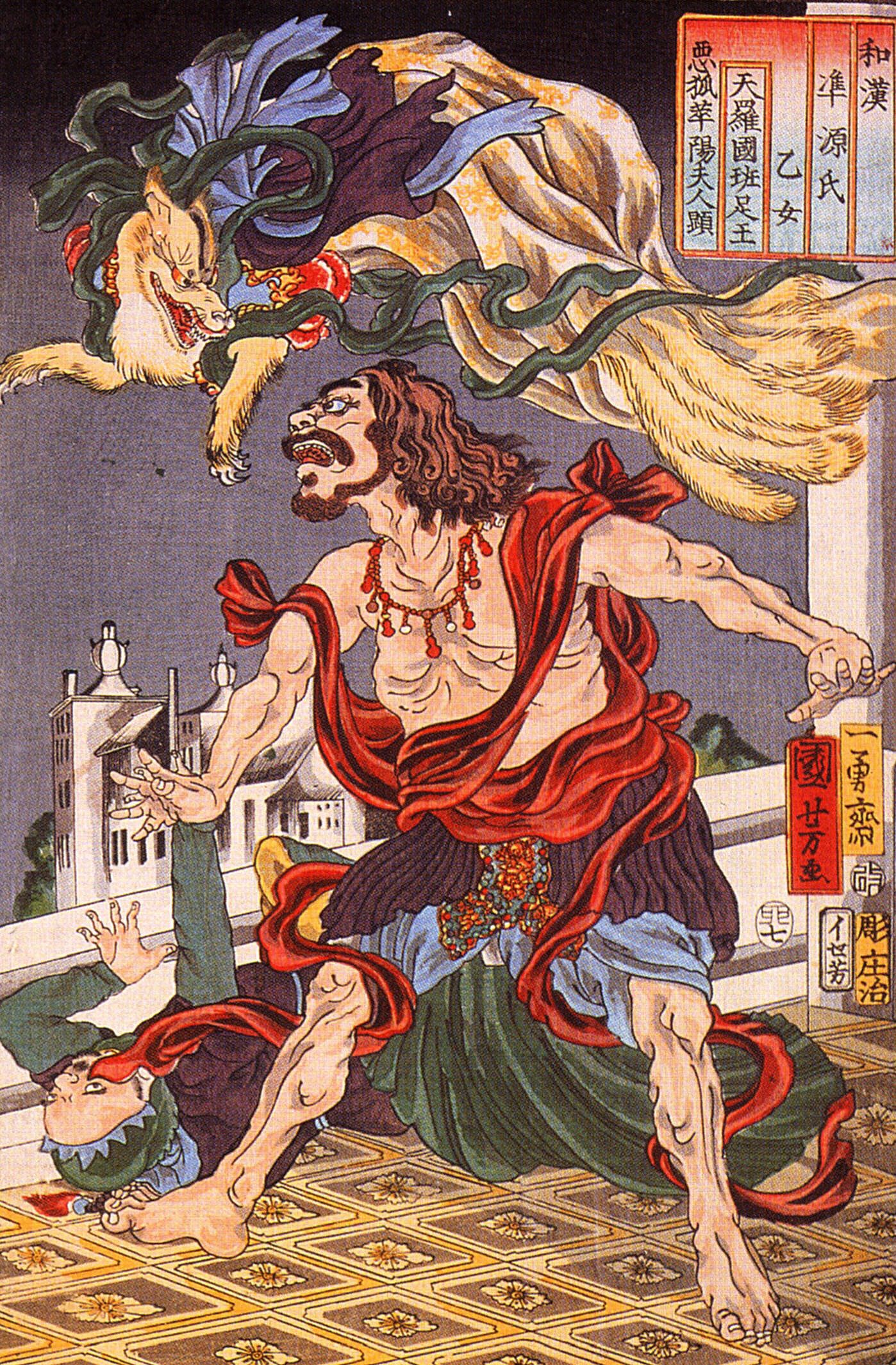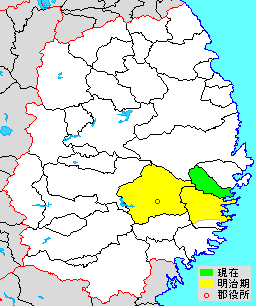|
Amefurikozō
is a type of Japanese ''yōkai''. There is a depiction of this ''yōkai'' in Sekien Toriyama's collection of ''yōkai'' drawing the ''Konjaku Gazu Zoku Hyakki'', and they can also be seen in the ''kibyōshi'' among other publications of the same era. Classics In the ''Konjaku Gazu Zoku Hyakki'' it wears a Japanese umbrella with its central pole missing, and it is depicted possessing a paper lantern. In the explanatory text, it says, "", stating that they are the jidō (children employed by the nobility) of the Chinese god of rain "Ushi". Since is an honorary title of the nobility (大人, "ushi"), and since can be understood as meaning "children", there is the interpretation that it is a yōkai depicted using a play on words "a child employed by an adult". In the kibyōshi of the Edo period, just like the popular kibyōshi character tōfu-kozō, they appear as yōkai that take on the role of servants. In the kibyōshi "" by Jihinari Sakuragawa and illustrated by Utagawa Toy ... [...More Info...] [...Related Items...] OR: [Wikipedia] [Google] [Baidu] |
List Of Legendary Creatures From Japan
The following is a list of demons, ghosts, and other legendary creatures that are notable in Japanese folklore and mythology. A B C D E F G H I J K M N O R S T ... [...More Info...] [...Related Items...] OR: [Wikipedia] [Google] [Baidu] |
Konjaku Gazu Zoku Hyakki
is the second book of Japanese artist Toriyama Sekien's famous ''Gazu Hyakki Yagyō'' tetralogy, published c. 1779. A version of the tetralogy translated and annotated in English was published in 2016. These books are supernatural bestiaries, collections of ghosts, spirits, spooks, and monsters, many of which Toriyama based on literature, folklore, other artwork. These works have had a profound influence on subsequent ''yōkai'' imagery in Japan. ''Konjaku Gazu Zoku Hyakki'' is preceded in the series by ''Gazu Hyakki Yagyō'', and succeeded by ''Konjaku Hyakki Shūi'' and ''Gazu Hyakki Tsurezure Bukuro''. List of creatures The three volumes were titled 雨, 晦, and 明. From this book, Toriyama added captions. First Volume – 雨 (Rain) Image:SekienOmagatoki.jpg, Image:SekienOni.jpg, Image:SekienSansei.jpg, Image:SekienHiderigami.jpg, Image:SekienSuiko.jpg, Image:SekienSatori.jpg, Image:SekienShuten-doji.jpg, Image:SekienHashihime.jpg, Image:SekienHannya.jpg, I ... [...More Info...] [...Related Items...] OR: [Wikipedia] [Google] [Baidu] |
Mizuki Shigeru Road
Mizuki is both a Japanese surname (みずき, ミズキ) and a unisex Japanese given name. Notable people with the name include: Surname *Alisa Mizuki, a J-pop singer and actress *Hakase Mizuki, Japanese manga artist *Ichirou Mizuki, an actor, voice actor and singer *Itagaki Mizuki, a Japanese actor and singer from EBiDAN's five-member vocal dance unit M!LK * Joh Mizuki, Japanese actor *Kaoru Mizuki, Japanese actress *Nana Mizuki, a Japanese voice actress and singer *Shigeru Mizuki, a Japanese manga artist and author of ''Ge Ge Ge no Kitaro'' Given name *Mizuki, a Japanese singer and member of Shiritsu Ebisu Chugaku *, Japanese footballer *Mizuki Fukumura, (譜久村 聖, born 1996) Japanese pop singer, Morning Musume member *Mizuki Hamada, (賓田 水輝, born 1990) American-born Japanese football defender *, Japanese footballer *Mizuki Inoue, (井上 水樹, born 1994) Japanese female kickboxer and mixed martial artist * Mizuki Kaminade, (上撫 瑞希, born 1995) Japanese profe ... [...More Info...] [...Related Items...] OR: [Wikipedia] [Google] [Baidu] |
Kitsune No Yomeiri
The Kitsune no Yomeiri (, "The Fox's Wedding") is a term or metaphor for certain natural phenomena, or a folk belief regarding a supernatural event, in Honshu, Shikoku, and Kyushu. The term "kitsune no yomeiri" can refer to several things: atmospheric ghost lights, in which it appears as if paper lanterns from a wedding procession are floating through the dark; sunshowers; or various other phenomena that may resemble wedding processions and are referenced in classical Japanese ''kaidan'', essays, and legends. The ''kitsune no yomeiri'' is always closely related to foxes, or ''kitsune,'' who often play tricks on humans in Japanese legend; various Shinto rituals and festive rites relating to the ''kitsune no yomeiri'' have been developed in various parts of Japan. As atmospheric ghost lights A topography book of the Echigo Province (now Niigata Prefecture), from the Hōreki period, the "Echigo Nayose" (越後名寄), includes the following statement about the appearance of the "kitsun ... [...More Info...] [...Related Items...] OR: [Wikipedia] [Google] [Baidu] |
Kitsune
In Japanese folklore, , are foxes that possess paranormal abilities that increase as they get older and wiser. According to ''yōkai'' folklore, all foxes have the ability to shapeshift into human form. While some folktales speak of employing this ability to trick others—as foxes in folklore often do—other stories portray them as faithful guardians, friends, and lovers. Foxes and humans lived close together in ancient Japan; this companionship gave rise to legends about the creatures. have become closely associated with Inari, a Shinto or spirit, and serve as its messengers. This role has reinforced the fox's supernatural significance. The more tails a has—they may have as many as nine—the older, wiser, and more powerful it is. Because of their potential power and influence, some people make sacrifices to them as to a deity. Conversely foxes were often seen as " witch animals", especially during the Edo period (1603–1867), and were thought of as goblins who could ... [...More Info...] [...Related Items...] OR: [Wikipedia] [Google] [Baidu] |
Iwate Prefecture
is a prefecture of Japan located in the Tōhoku region of Honshu. It is the second-largest Japanese prefecture at , with a population of 1,210,534 (as of October 1, 2020). Iwate Prefecture borders Aomori Prefecture to the north, Akita Prefecture to the west, and Miyagi Prefecture to the south. Morioka is the capital and largest city of Iwate Prefecture; other major cities include Ichinoseki, Ōshū, and Hanamaki. Located on Japan's Pacific Ocean coast, Iwate Prefecture features the easternmost point of Honshu at Cape Todo, and shares the highest peaks of the Ōu Mountains—the longest mountain range in Japan—at the border with Akita Prefecture. Iwate Prefecture is home to famous attractions such as Morioka Castle, the Buddhist temples of Hiraizumi including Chūson-ji and Mōtsū-ji, the Fujiwara no Sato movie lot and theme park in Ōshū, and the Tenshochi park in Kitakami known for its huge, ancient cherry trees. Iwate has the lowest population density of any prefecture ... [...More Info...] [...Related Items...] OR: [Wikipedia] [Google] [Baidu] |
Kamihei District, Iwate
is a rural district in Iwate Prefecture, Japan. From 2005, the district consists only of the town of Ōtsuchi, which as of June 1, 2019 had an estimated population of 11,106 with a density of 55.4 per km2 and an area of 200.42 km2. The entire city of Tōno, and all of the city of Kamaishi with the exception of the village of Tōni were formerly part of Kamihei District. Towns and villages The district consists of one town: *Ōtsuchi History Under Mutsu Province Hei District was one of the Edo period districts of Mutsu Province under the Tokugawa shogunate and was completely under the control of Nanbu clan of Morioka Domain. Following the Meiji restoration, on January 4, 1879 Hei District came under Rikuchū Province was an old province in the area of Iwate and Akita Prefectures. Nussbaum, Louis-Frédéric. (2005). "''Rikuchū''" in . It was sometimes called , with Rikuzen and Mutsu Provinces. Rikuchu covered most of modern-day Iwate Prefecture: with the ... and w ... [...More Info...] [...Related Items...] OR: [Wikipedia] [Google] [Baidu] |
Norio Yamada
Norio (written: , , , , , , , , , , , , , , , , , , , , , , or in hiragana) is a masculine Japanese given name. Notable people with the name include: *, Japanese rower *Norio Hayakawa (born 1944), American activist *, Japanese speed skater *, Japanese professional wrestler *, Japanese cyclist *, Japanese actor *, Japanese journalist *, Japanese ice hockey player *, Japanese astronomer *, Japanese photographer *, Japanese Go player *, Japanese jazz composer and pianist *Norio Matsubara (born 1968), Brazilian racing driver *, Japanese golfer *, Japanese politician *, Japanese footballer *, Japanese spree killer and writer *, Japanese writer *, Japanese physician and geneticist *Norio Nishiyama, Japanese mixed martial artist *, Japanese chief executive *, Japanese footballer *, Japanese footballer and manager *, Japanese basketball coach *, Japanese sumo wrestler *, Japanese golfer *, Japanese animator, illustrator and character designer *, Japanese explorer *, Japanese footballer *, ... [...More Info...] [...Related Items...] OR: [Wikipedia] [Google] [Baidu] |
Tottori Prefecture
is a prefecture of Japan located in the Chūgoku region of Honshu. Tottori Prefecture is the least populous prefecture of Japan at 570,569 (2016) and has a geographic area of . Tottori Prefecture borders Shimane Prefecture to the west, Hiroshima Prefecture to the southwest, Okayama Prefecture to the south, and Hyōgo Prefecture to the east. Tottori is the capital and largest city of Tottori Prefecture, with other major cities including Yonago, Kurayoshi, and Sakaiminato. Tottori Prefecture is home to the Tottori Sand Dunes, the largest sand dunes system in Japan, and Mount Daisen, the highest peak in the Chūgoku Mountains. Etymology The word "Tottori" in Japanese is formed from two ''kanji'' characters. The first, , means "bird" and the second, means "to get". Early residents in the area made their living catching the region's plentiful waterfowl. The name first appears in the Nihon shoki in the 23rd year of the Emperor Suinin (213 AD) when Yukuha Tana, an elder from the ... [...More Info...] [...Related Items...] OR: [Wikipedia] [Google] [Baidu] |
Sakaiminato, Tottori
is a city in Tottori Prefecture, Japan. In 2016, it had an estimated population of 33,888. History An Imperial decree in July 1899 established Sakai as an open port for trading with the United States and the United Kingdom. Sakaiminato was founded on April 1, 1956. A merger with Yonago and other neighboring municipalities was proposed, but the majority of the citizens voted against this, and Sakaiminato remained an autonomous municipality. Sakaiminato was the only Japanese municipality to have a twin town agreement with a North Korean city from 1992 to 2006. In 2006, Mayor Katsuji Nakamura revoke the agreement in response to North Korea's announcement of a nuclear test along with the Japanese government's decision to impose economic sanctions. Actual twin town activities had already come to an end by 2002, after which the cities had only sent each other a letter once per year. Geography At the northern end of Yumigahama Peninsula, it is surrounded by the Miho Bay on the Sea o ... [...More Info...] [...Related Items...] OR: [Wikipedia] [Google] [Baidu] |
Heisei
The is the period of Japanese history corresponding to the reign of Emperor Emeritus Akihito from 8 January 1989 until his abdication on 30 April 2019. The Heisei era started on 8 January 1989, the day after the death of the Emperor Hirohito, when his son, Akihito, acceded to the throne as the 125th Emperor. In accordance with Japanese customs, Hirohito was posthumously renamed "Emperor Shōwa" on 31 January 1989. Thus, 1989 corresponds to Shōwa 64 until 7 January, and from 8 January. The Heisei era ended on 30 April 2019 (Heisei 31), with the abdication of Akihito from the Chrysanthemum Throne. It was succeeded by the Reiwa era as then-crown prince Naruhito ascended the throne on 1 May midnight local time. History and meaning On 7 January 1989, at 07:55 AM JST, the Grand Steward of Japan's Imperial Household Agency, Shōichi Fujimori, announced Emperor Hirohito's death at 6:33 AM JST, and revealed details about his cancer for the first time. Shortly after the de ... [...More Info...] [...Related Items...] OR: [Wikipedia] [Google] [Baidu] |






